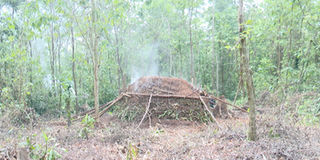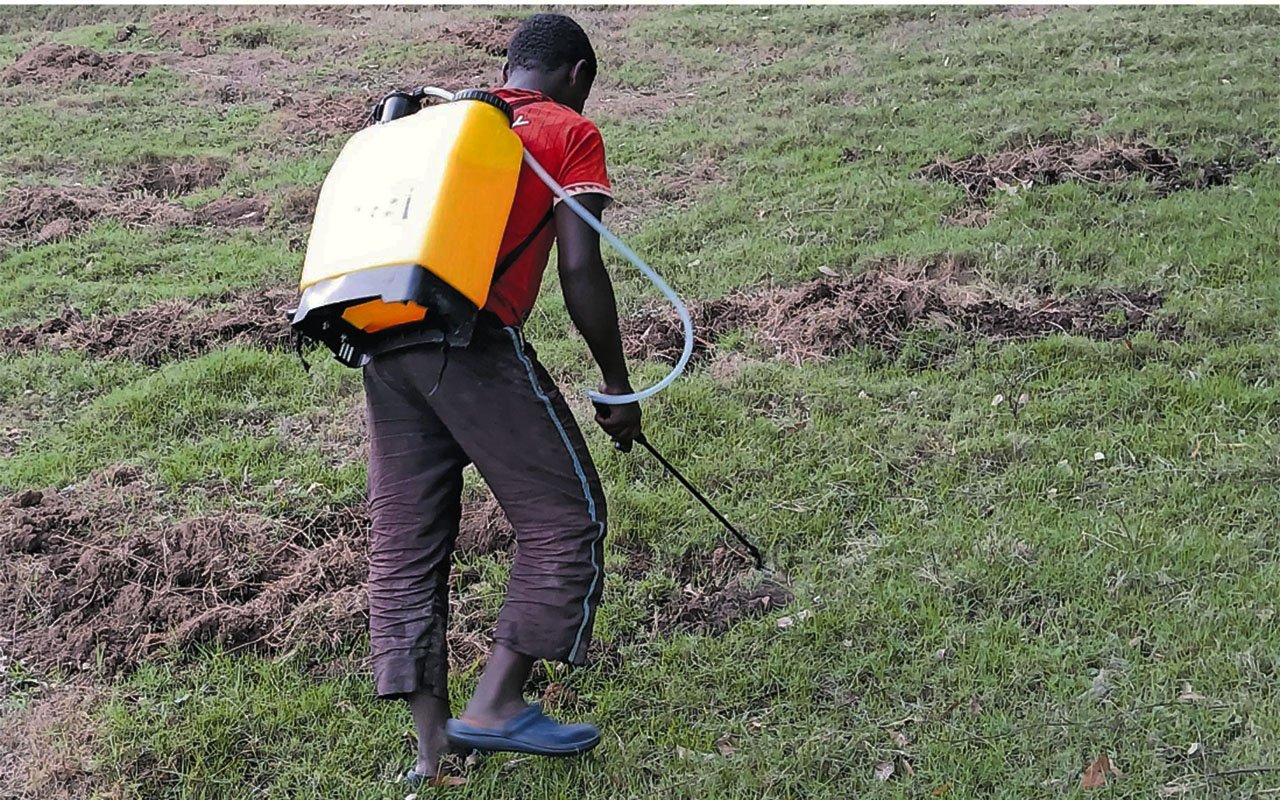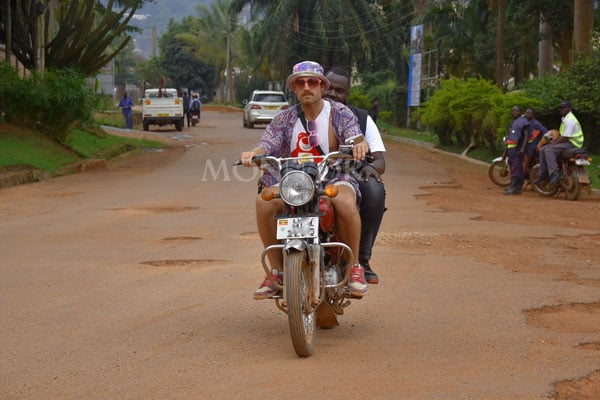Prime
Mabira: A forest in the throes of extinction

Charcoal burning in Mabira Forest. Photo | Sudhir Byaruhanga
What you need to know:
- While locals and government officials continue to bicker on who is responsible for protecting the natural forest, illegal loggers and squatters are taking advantage of the situation to clear it, writes Sudhir Byaruhanga.
Mabira, one of Uganda’s largest natural forests, lies at the edge of Buikwe and Jinja districts, and across the rustic sugar-belt. Previously, it was composed of a sprawling 300-square km of trees and served as a habitat for the colobus monkey and chatting birds, and its flora was harvested as natural medicine to treat ailments.
The forest sustained reliable rainfall. With the ravaging effects of climate change, the harvest in their gardens continues to dwindle.
Like a festering wound, Mabira’s trees continue to rapidly diminish even after a Nation Media Group story published in February 2018 revealed widespread illicit logging—an expose that elicited uproar. In response, Parliament tasked the Ministry of Environment to explain why government agencies such as the National Environment Management Authority, and National Forestry Authority had abandoned their responsibility to protect such a vital natural resource.
As the sun in its orange glow majestically sets across the horizon in the evening, dusk gradually envelopes this humble hamlet turning the skies into a pitch-black ball. Through one narrow path used by the loggers at Nagojje Wasswa, we can see a settlement in the middle of the forest.
Here, the first signs of recent logging emerge and large tree stumps bear a fresh scent. This is in stark contrast with the tree stumps in other areas, which are drying, indicating that the logging may not be recent.
As the hues of light flicker through the canopy of trees at the crack of dawn, our feet are washed by the morning dew. During our search, we find another area where recently cut logs are assembled on an erected platform.
The loggers later slice them into timber. It is visible that the loggers had been here a few days back. These loggers are wasteful and often abandon trees that are not deemed good for timber.
This is evidenced by several big trees which are sanctuary for monkeys, cut and left to rot away.
The loggers have built a network of loyal spies across the grassroots who are sustained by this lucrative trade in illicit timber.
“When you suspect intruders in the forest and call the forestry rangers, they will confirm to you that they are not the ones and then advise you to continue working,” a local guide who spoke on condition of anonymity revealed.
As doubts lingered, I perhaps wondered whether the loggers who have a strong sense of smell, discovered a fresh scent or discovered new footprints that may have raised suspicion. We depended on bread and water while inside the forest for breakfast and lunch to avoid strange smells that could easily be detected.
We agreed to change location to another backwater at Kinoni Gangu near Najjembe Market. Across this part of the forest, the illicit activity taking place is charcoal burning. Trailing footprints and sounds, we located a man involved in charcoal burning. He is not bothered that he may be caught that he conducts his illegal activities from dusk to dawn, making his way out of the forest at about 6:30am.
The scent of fresh ash and unburnt pieces of wood from the charcoal pile permeate across a large section of this forest. The loggers have turned these empty spaces that once hosted trees into their marijuana gardens. We were told that one mature plant can fetch up to Shs10,000.
Inside the deeper recesses, we found some of the trees that had been freshly cut. The loggers here use axes to fell trees in a forest guarded by National Forestry Authority personnel. It appears strange that the law enforcement officers cannot hear the thud of falling trees reverberating across the forest. But the officials are a paltry number to be able to provide adequate security for this vast expanse.
“They have no capacity in terms of patrolling and ground management like we see in Uganda Wildlife Authority where we have effective boundary surveillance and protected area control because of the personnel. When you compare, Uganda Wildlife Authority has 3,000 personnel with a huge budget of about Shs120b but National Forestry Authority has a budget of about Shs26b,” Mr Barirega Akanwasah, the executive director of National Environment Management Authority, which oversees all the other agencies, told us.
“So you can see the difference. They have that budget, with 3,000 staff. We have 400 staff yet managing almost the same area size,” he added.
In another area, a charcoal burner spends the day preparing logs and later lights a fire, which burns for two days before the wood is carbonised.

Mabira Forest tour guides direct tourists on one of the famous Mabira Forest trails known as the Red Trail. Due to limited enforcement, the forest is being depleted by illegal loggers PHOTO | FILE
About 60 metres from our hiding place, we spotted a huge charcoal pile. All the trees and trunks on the ground here have been cleared. The pile is so big and the owner is estimated to get about 20 bags of charcoal.
The following day, the drone operator, Nelson Nuwaha, joined us. Our mission was to use aerial filming to show the extent of this illicit logging.
We repeated the routine and as usual tried to reach the forest early to avoid detection. Our intention is to capture the owners of the biggest charcoal pile about to make a harvest.
As we got closer, one of the men who spent a night guarding the pile, became suspicious. He asked whether we were looking for charcoal and we replied in the affirmative. He then told us that he did not have charcoal while brandishing his machete in front of his burning charcoal pile.
We retreated and hid not far from him. And shortly after dawn, we flew a drone to capture what was taking place. We heard the loggers saying they had seen our drone fly above them. Some hid to avoid being filmed.
We could not continue to film and dashed out of the forest for fear of being attacked. In this panic, I momentarily failed to locate one of our colleagues and the local guide.
Speaking through muted tones on the phones against the chirping sound of the birds, I was able to later identify their locations.
To avoid being predictable, we abandoned the route we usually took and opted to pass through a meandering stream wading knee-deep for about 200 meters before finding our way to a vantage point, where we were able to see the charcoal dealers carrying spades and hoes headed for the forest.
We remained hiding and four hours later, they emerged out with sacks of charcoal. These men only communicated through sign language to avoid being heard.
“National Forestry Authority does not give movement permits for any forest products in a natural forest. The movement permit for charcoal burning and timber are given out by local governments who are using natural forests as their source of tax revenue. Here, we are saying this is illegal,” Mr Stuart Maniraguha, the director for Plantations Development at National Forestry Authority, said.
The following day we moved to another area where illicit logging was taking place called Kasokoso. At dawn, we hid in the tall grass and waited for the loggers. However, throughout the day, nobody showed up. We then moved to another location in the same section of the forest, we found many spots where trees were recently felled.
Suddenly, the clouds turned grey and heavy rains pounded the area, sending us to scamper for shelter. Yet, this offered the best chance for us to stealthily track the loggers under the cover of darkness.
For another two hours, we remained on the trail of these loggers. At this vantage point, we were able to film some illicit loggers cutting timber with handsaws. They did not seem bothered that they would be caught.
“We just have eight forest supervisors supported by four patrol men, each having sticks. Then you have three policemen and UPDF soldiers who are armed with guns. This number can’t protect the forest because the pressure is high. Have we interrogated the population around and within the forest? What alternatives are we creating for these people who live here?” Mr Maniraguha said.
The locals claim that these loggers report to their masters who connive with the National Forestry Authority staff.
“They always beat the locals who cut the trees but allow their own [National Forestry Authority] people inside. Sometimes they even use power saws which locals can’t easily access. Some fail to collaborate with the forestry staff but have a rapport with soldiers guarding the forest,” Mr Kyobe Kaaso, the chairperson of Najjembe Village said.
Additionally, Mr Livingstone Damba, the defence chairperson of Kasokoso Zone, said: “I was born in 1964, this forest used to be guarded by locals with machetes and it was intact. But ever since they brought the army and police, illegal activities increased.”

A man logs timber in Mabira Forest. Photo | Sudhir Byaruhanga
In response, Mr Maniraguha said “If the local leaders are accusing National Forestry Authority of connivance, it means they are failing on their mandate. The law gives them responsibility as primary leaders to protect and manage government resources. What actions are they taking?’
Although the illicit loggers we exposed in 2018 were not apprehended, Mr Maniraguha told this publication that some of the National Forestry Authority staff who connived with loggers were punished.
“There should be an appreciation that National Forestry Authority did an internal investigation that led to the dismissal of three staff who we found to have been involved in such acts. That has sent a signal to others that we have zero tolerance to such acts,” Mr Muniraguha said.
Some locals who stay on the outskirts of the forest claimed to own titles for parcels in Mabira Forest.
“Using our own intelligence, we were able to identify four illegal tittles. We submitted them to the Ministry of Lands for cancellation, of which we succeeded. The title holders never show themselves, they front the degraders to clear the sections they want to grab. There is a claim of more than 5,000 acres, equivalent to more than eight square miles of the Mabira Forest,” Mr Maniraguha said.
On our last day inside the forest, we returned to Kasokoso Zone.
Heavy rains pounded this area at about 6am as we approached the outskirts of the forest. We were able to trace the fresh foot-prints of the loggers.
We hid near the banana and coffee plantation.
When it ceased raining, the gladiatorial beasts of the jungle noticed strange foot-prints and unleashed hounds to track us.
The barking dogs came as close as 10 metres from where we were hiding and failed to trace us. Perhaps the rains had washed away our scents.
Minutes later, the illicit loggers brandished their sharp machetes in a mock exercise to instil fear among those trailing them. The other men who are part of the cartel, gradually emerged out of their hiding place with the timber.
To ease transportation, they divided the logs into big chunks of wood which were transported to holding stores and later ferried using trucks or boda bodas.
We could not follow the loggers up to their store as this seemed extremely dangerous. We, however, moved to the section near Griffin falls next to Lugazi sugar plantation. Here, the loggers use one section of the broken bridge to transport the large timber logs.
Some of the boda bodas transported the logs to Lugazi Town.
Timber business is booming in this bustling town of Lugazi.
“The main timber market is Lugazi and Jinja. The buyers from Kampala pick it from Jinja,” one of the residents who preferred anonymity said.
The entire 300 square km stretch of Mabira Forest is guarded by only eight National Forestry Authority staff operating with one pickup and about four armed police and UPDF soldiers.
A National Forestry Authority supervisor earns a monthly salary of Shs1 million while the security personnel attached to the Authority officials only get Shs100,000 as food allowance, which is often paid late.
Mr Akankwasa says there is need to strengthen the enforcement team.
“Can we all fight for that. Can the leaders take their role to manage national assets as required by the Constitution?” he asked.




